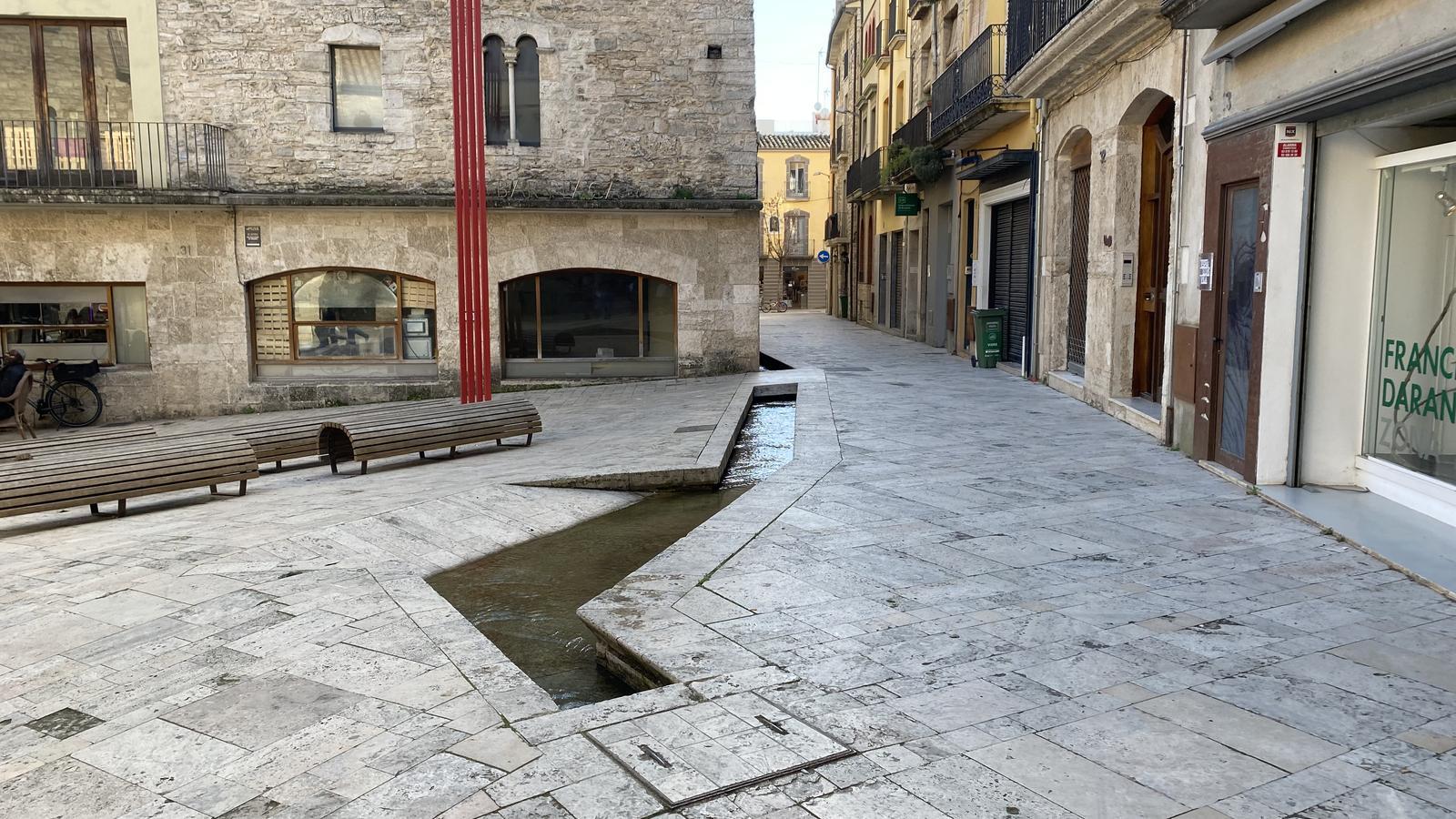Three children each make paper boats at a time. They release them into the water, into the drinking fountains, and they begin to sail, now outdoors, now underground, passing through the Plaza Mayor, along Carrer del Born... Each child has their boat marked with a symbol so they can identify it... and know if they win when they collect it at the Plaza del Teatro.
For a few years now, the irrigation ditches of Banyoles have once again become a playground, as they once were. Some people would soak in the water—especially in the first stretches, where the water was cleaner—or chase eels with their hands. Others would wash clothes—and other things, like pig guts during slaughter season.
We're on the main canal in Banyoles. Most of the mills in the capital of the Pla de l'Estany region were concentrated along its course. Wool cloth, paper, flour, leather, and even gunpowder and chocolate were produced there. Yes, starting in the 18th century, some flour and paper mills began grinding cocoa (and cinnamon) to make chocolate. Several chocolate factories were established, one of which is still very active: Chocolates Torras.
At the mills, a small jump of a couple or three meters was enough. The water that flowed from one mill was irrigated downstream and moved to the next mill.
"The irrigation ditches became sewers when the mills and orchards behind the houses disappeared. They were visible, but they were covered up. Our goal was for the irrigation ditches to have clean water and fish. But, of course, that meant that most of the houses had to have work done to fix the downpipes; even at the beginning of the 21st century in Banyoles, sinks, toilets, and washbasins sent filth down the irrigation channel," explains Josep Miàs, the architect responsible for the pedestrian project in the old quarter of Banyoles. "The project generated some opposition. Not everyone welcomed it; it received many comments, not always positive," he tells me. "It's very difficult to play at home (unlike football)," he acknowledges.
As we walk, Josep explains to me that he works as a draftsman. "It's impossible for me to think without drawing. In fact, I'm only capable of thinking what I'm capable of drawing," says Miàs. What he draws happens in three dimensions, with wire. A set of wire models made by Miàs are on display at the Centre Pompidou. This important Parisian center also houses the drawings for the renovation project for the old town of Banyoles, where irrigation ditches—and pedestrians—are the protagonists.
In reality, what has been done in Banyoles is what has been done in virtually every city in Catalonia: allowing pedestrians to walk freely through the public spaces in their core. But in Banyoles, this process has perhaps been more radical. Here, cars parked everywhere, even under the alleys of the Plaza Mayor! And there's another determining factor—and attraction—the irrigation ditches.
The son of a housewife and a bricklayer, a multi-award-winning Banyoles architect, both here and abroad (for example, he received the International Stone Award for this project, which is being carried out, obviously, in Rome), Josep Miàs identifies with the idea of being a radical architect—radical comes from the roots, and the irrigation canal project represents a return to the roots of Banyoles. An admirer and collaborator of the late Enric Miralles, Miàs has designed projects as diverse as the new Tibidabo funicular, the new Barceloneta Market, the Girona park and central station, and the iGuzzini headquarters in Barcelona. He has done relatively little work in his hometown—he renovated the Bans V (still unfinished). The "recovery" of the pedestrianized old town of Banyoles is his major work in Banyoles, the one that has accompanied him intermittently for the last twenty years, and he is still not finished: he still has to reach the monastery. "Public space is the one we architects must take the most care of," says Miàs, as we enter the mill in the square, an old flour mill. Its mechanism still works with water from the irrigation ditch for visitors.
"The project has been complex. In the Major irrigation channel, as it flows through the old town, there is now a surface channel—what you can see—with a constant water level. When the water level rises, it flows into a lower channel, which runs just below," explains Josep Miàs. We are now in the Plaça del Teatre. There is a kind of small beach: a natural spillway, which descends towards the irrigation channel. This beach is made of travertine stone, like much of the pedestrian area. Travertine (they call it "Banyoles stone" here) is a native limestone used to build Banyoles' main buildings.
We finished the visit near the pond, in front of a curious triangular stone called The limitIt is located just above the main irrigation channel and acts as a barrier to water: it forces it to flow beneath it, thus regulating its flow. Its construction is unknown, but it is described in a document from 1832 as a "boundary bridge to divert water during times of heavy rain."
If you go to Banyoles, don't just "do" the pond. Go to the old town to enjoy the soundtrack of the water flowing through the irrigation ditches.
The water from the pond and the ditches belonged to the kings
The first irrigation ditches in Banyoles were built in the 9th century to supply water to the Sant Esteve monastery, drain wetland areas, and create new farmland.
The waters of the pond and the irrigation ditches belonged to the king, but both the monks and the villagers considered them their own. In fact, the abbot collected fees from irrigators and millers. From the 9th to the 17th century, there were disagreements and disputes. In 1685, the Concord of the Waters of the Pond was signed, a document that laid the foundations that have led to the pond's water being a communal good today.


